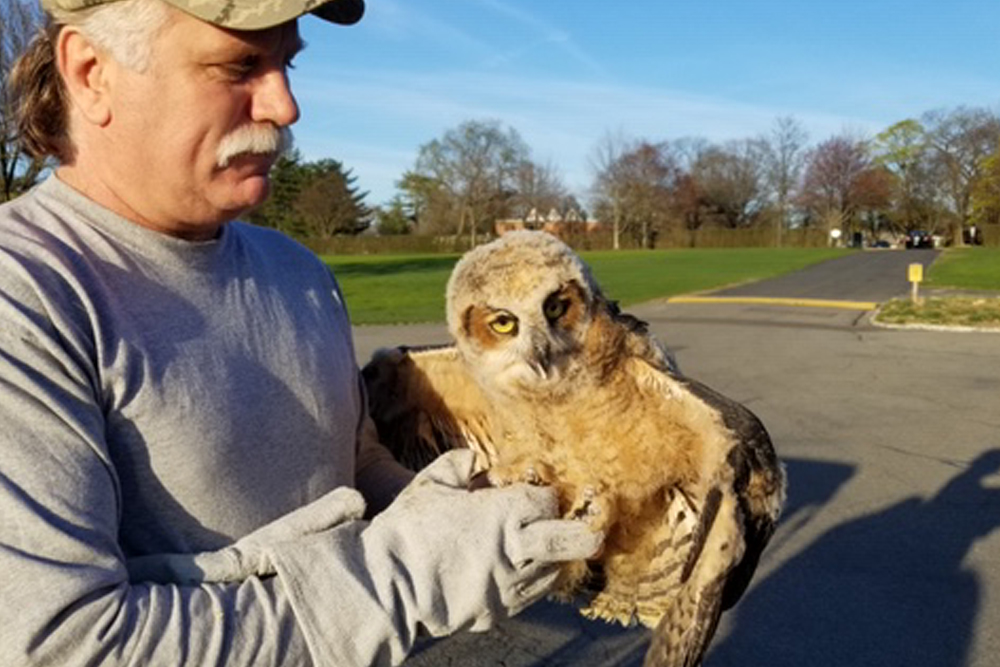Adelphi University's campus is home to many creatures, such as bunnies, squirrels, and a multitude of birds—but seldom owls. That changed on the evening of April 10, when one of our feathered friends found itself in a bit of trouble and two of our students came to the rescue.

The young owl is being rehabilitated by Bobby Horvath of North Massapequa-based Wildlife in Need of Rescue and Rehabilitation.
» See a story on PIX 11 News about the owl rescue
Adelphi University’s campus is home to many creatures, such as bunnies, squirrels and a multitude of birds—but seldom owls. That changed on the evening of April 10, when one of our feathered friends found itself in a bit of trouble and two of our students came to the rescue.
Adelphi sophomores Christina Sourlis and Taylor Arma were driving on South Avenue, near the main campus entrance, when they noticed a fuzzy creature in the middle of the road. They pulled over, got out, and discovered a five-week-old great horned owl that had fallen out of its nest.
The two students acted quickly. They shooed the owl away from the train tracks and to a safe place on the sidewalk.
“I have three dogs and a cat that I rescued from the streets,” said Arma. “So jumping out of the car to get the owl to safety was a natural instinct.”
“Living on Long Island, it is not common to see an owl,” said Sourlis. “We wanted to find help for it as soon as possible.”
They contacted Adelphi’s Department of Public Safety and Transportation. According to Michael McGuinness, assistant director of operations, “Public Safety Officer Fred Wing, who has been with the department for five years, responded to investigate and render assistance.”
Officer Wing called the New York State Department of Environmental Conservation, which put him in touch with Bobby Horvath, a wildlife rehabilitator with the North Massapequa-based Wildlife in Need of Rescue and Rehabilitation (WINORR). Horvath responded to the scene, where he was able to gain control of the young owl. As it is too dangerous to leave a flightless fowl in the wild, Horvath took it home with him.
Assistant Professor of Biology Carolyn Bauer, Ph.D., said there are several scenarios that could have led to the owlet’s plight. “Jays and crows will often mob owls, so perhaps it was injured that way,” she said. “Great horned owls do venture from the nest before they can fly; it’s very common—so it’s possible it fell and got its wing caught on something. The other possibility is that the parents died, and the owl was forced to look for food on its own,” although she said the parents could also be around the nest, “as they’re very good at camouflaging.”
In the days following the rescue, Horvath found the owl’s nest, located in a tall tree just south of South Avenue, but it was empty—no parents in sight. Without the owlet’s family, it could not survive on its own, especially with an injured wing.
The young owl is now in the capable hands of Horvath, who will raise and rehabilitate it for the next few months, then release it back into the community when it is ready. Horvath said if the students had not acted as they did, the owl may not have survived: “These young students were very caring and thoughtful in their actions and should be proud of themselves.”
Get Wise to These Facts About Great Horned Owls
Dr. Bauer offered these insights into owls and owl behavior:
- Great horned owls are fairly common across North America.
- Nests typically contain one to three eggs, but the fatality rate is high.
- When the young owls are 6 to 8 weeks old, they begin to venture from their nest. Although they’re not ready to fly, they are ready to start climbing on branches to develop their leg muscles, which they’ll need to use to catch their own prey.
- Parents take care of the fledglings for many months, although they may not use the nest so much once the fledglings can fly well.
- Since owls are nocturnal, they’re hard to find unless they’re making their mating calls.
- Crows or jays will mob owls and other birds of prey during the day.
- Owls eat rodents, rabbits, small birds and just about any kind of prey they can get.
- The best place for a rescued nesting owl that cannot feed itself is back with its parents or with foster parents; adult owls will raise young that are not their own. Nesting owls fed and cared for by humans may imprint and identify with people, not owls, and can seldom be released back into the wild.
- Dr. Bauer said this owl is probably old enough to feed itself, so its chances of survival are good.
For further information, please contact:
Todd Wilson
Strategic Communications Director
p – 516.237.8634
e – twilson@adelphi.edu